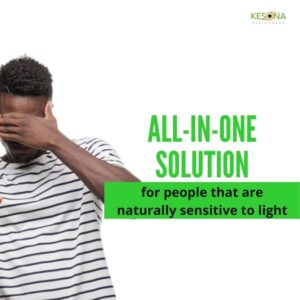Light sensitivity is the intolerance of the eyes to normal levels of bright light. It is also known as photophobia. It is characterized by the feeling of discomfort and squinting that occurs on exposure to light.
The threshold for bright light varies from person to person and this is determined by a number of factors such as the pigmentation of the skin and iris, pupil size as well the presence of some diseases and conditions.
The pigment (melanin), which gives the skin and eye a dark colour, helps absorbs light. Therefore, dark-skinned people with brown iris tend to be less sensitive to light than light-skinned people with blue or grey iris.
The pupils regulate the amount of light that gets into the eyes. When the eyes are exposed to bright light, the pupils constrict, limiting the amount of light that enters into them. Under dim lighting, the pupils dilate, allowing more light to pass through the eyes. People with large-sized pupils tend to be more light-sensitive than those with normal-sized pupils because the large pupils allow more light into the eye than the normal-sized pupils.
Some diseases and eye conditions can cause abnormal light sensitivity. So, it is necessary to see an eye doctor if you suddenly notice that you are unusually sensitive to light.
Conditions that cause light sensitivity
- Albinism: This is an inherited genetic condition that results in lack of pigment (melanin) in the skin, hair and eyes. Light sensitivity is one the biggest problems of people who lack pigment in the eye (ocular albinism). In addition to light sensitivity, persons with ocular albinism may have low vision, refractive errors, misaligned eyes and nystagmus (repetitive, uncontrolled movement of the eyes).
- Ocular infections and inflammations: Eye infections like infective conjunctivitis, keratitis, anterior uveitis, endophthalmitis and other eye inflammatory conditions cause unusual sensitivity to light.
- Migraine headaches: This is a severe headache that occurs on one side of the head. It is usually accompanied by visual aura, nausea or vomiting and increased sensitivity to light and sound. Due to the increased sensitivity to light and sound, people who have migraine often go into dark, quiet places to rest.
- Corneal abrasion and ulcers: These corneal conditions have light sensitivity and severe pains as major symptoms.
- Dry Eye syndrome: Dry eye syndrome associated with corneal damage causes severe light sensitivity because the cornea is affected. People with this condition usually need aggressive lubrication of the eyes to relieve the symptom.
- Eye surgeries: People that have undergone eye surgeries such as cataract extraction experience unusual light sensitivity. One reason for that is the eye inflammation that occurs after surgery. Another reason is that the clear intraocular lens that is used to replace the opaque lens allows more light into the eye. These days, there are intraocular lenses with UV protection made to protect the eyes.
- Brain infections and injuries: Light sensitivity is experienced by people with infections like meningitis or injuries such as concussion.
- Medications: Some eye drops such as those used to dilate the eyes like atropine and tropicamide cause light sensitivity and blurred vision. Other drugs that can cause light sensitivity include tetracycline, doxycycline, quinine, cocaine and morphine. There is need to alert your doctor if you experience light sensitivity when taking your medications.
Treatment of light sensitivity
Treatment of light sensitivity is targeted at the cause or the condition responsible for it.
If it is caused by infections, inflammations or injuries, medications may be prescribed. If it is caused by your medications, your doctor may change your medication or recommend ways to minimize symptoms until you have completed your medications.
If there is no pathological condition responsible for your light sensitivity, you may be naturally sensitive to light. In this case, making effort to avoid or minimize the exposure of your eyes to uncomfortable light sources would help. You can do this by wearing wear face caps/hats and/or using umbrellas under the sun.
Eyeglasses such as sunglasses and glasses with photochromic lenses may be prescribed to provide protection from glare and ease eye discomfort.
